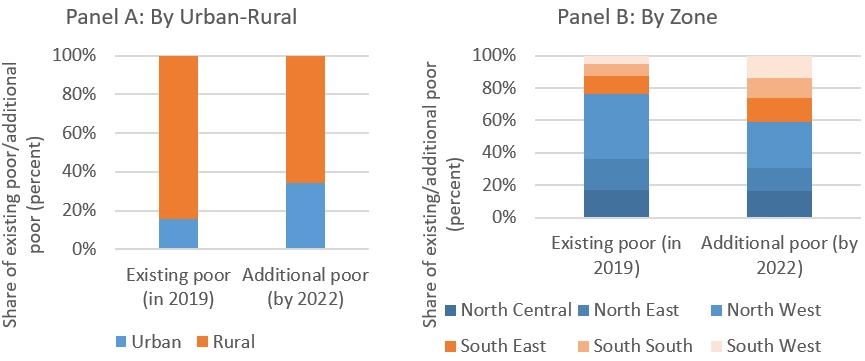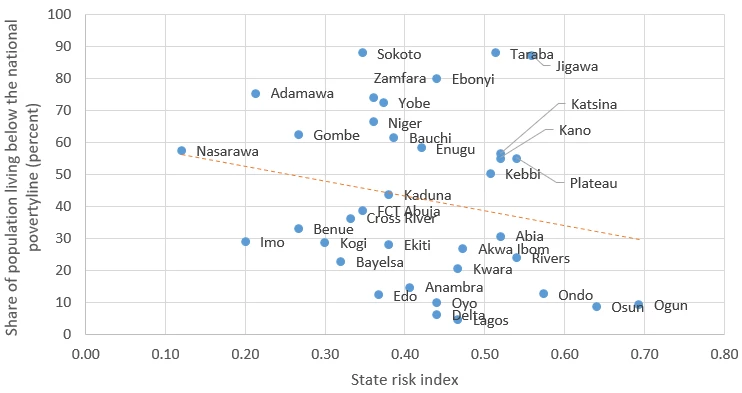The COVID-19 crisis is affecting all Nigerians, but different groups face different impacts on their health, welfare, and livelihoods. As such, no single, monolithic solution exists to the crisis: countervailing welfare policies need to reflect these differences and deliver support aligned to communities’ specific needs. To achieve this, Nigeria’s policy makers need information on COVID-19 risks and vulnerabilities in specific population groups.
Since available evidence is scant, we can use two approaches to try and triangulate information on which groups to target for measures that counteract the effects of the COVID-19 crisis. First, simple macro-micro simulations—which combine the latest microdata with macroeconomic forecasts—can tell us how much poverty is likely to rise as the crisis advances and which broad groups of people will be affected.[1] Second, detailed state-representative data from just before the outbreak can tell us more precisely which communities are most vulnerable to the different public-health and economic risks posed by the crisis.
Poverty looms for millions of Nigerians due to COVID-19
The macro-micro simulations show that more than 10 million Nigerians could be pushed into poverty by the economic effects of the COVID-19 crisis alone. Were the crisis not to have hit (a “counterfactual” scenario), the poverty headcount rate—as per the national poverty line—would remain virtually unchanged at a little over 40%, although the number of poor people would be set to rise from 82.9 million in 2019 to 90.0 million in 2022 due to natural population growth (see Figure 1).[2] Yet with the economic effects of the COVID-19 crisis, the national poverty rate is instead forecast to jump from 40.1% in 2019 to 45.2% in 2022, implying that 100.9 million Nigerians will be living in poverty by 2022. Taking the difference between these two scenarios shows that the COVID-19 crisis alone is forecast to drive an additional 10.9 million people into poverty by 2022. What is more, these simulations only cover monetary poverty: multidimensional poverty is even more widespread in Nigeria and is also set to rise as the crisis evolves.
Figure 1. The COVID-19 crisis may push more than 10 million additional people into poverty by 2022

The pandemic is changing the profile of the poor
Nigerians newly impoverished by COVID-19 are projected to differ in important ways from those who were already poor before the pandemic. This in itself necessitates new approaches to targeting countervailing social protection measures. On average, Nigerians forced into poverty by COVID-19 are set to be more southern, more urban, and more likely to work in the service sector than those who were already poor (see Figure 2). Reinforcing these simulations, data from the National Longitudinal Phone Survey (NLPS)—a monthly survey currently being implemented by the National Bureau of Statistics (NBS) with technical support from the World Bank—also suggest that urban Nigerians working in services and commerce were hit especially hard as the pandemic broke. The NLPS data further show that, despite many Nigerians’ subsequently returning to work, households remain economically precarious as their incomes are lower than last year and they are more food insecure.
Figure 2. A disproportionate share of newly impoverished Nigerians are predicted to live in urban areas in the south of the country

State-representative data can shape policy to local needs
Simulations, however, can only get us so far. By showing the dramatic extent to which poverty may rise through the COVID-19 crisis, they serve as a crucial call to action. Yet, since the simulations depend mechanically on sectoral growth forecasts, which themselves may be noisy, they cannot be used on their own to delineate the specific policy packages and targeting strategies that are needed to combat the COVID-19 crisis in Nigeria.
For more geographical disaggregation and to go beyond the direct economic effects on GDP, jobs, and incomes, we can turn to more detailed state-representative data gathered just before the pandemic struck. In a new paper, we present a simple “state pandemic risk index” that measures multiple dimensions of public-health and economic vulnerability to the COVID-19 crisis in Nigerian states. The index combines pre-crisis information on health and household demographics, income sources, local services, infrastructure, and population density, drawing on the recently released 2018/19 Nigerian Living Standards Survey (NLSS) as well as the 2018 Demographic and Health Survey (DHS).
Looking at each component of the index generates state risk profiles that can be used to tailor COVID-19 policy packages to states’ specific needs. For example, several states in northern Nigeria—especially Kebbi, Niger, and Sokoto—are particularly exposed to the effects of COVID-19 through their lack of infrastructure (see Figure 3). These states may get outstanding benefits from water, sanitation, and hygiene programs to prevent disease spread. In contrast, in many southern states, health risks are amplified because populations are older and more urban, with more pre-existing health conditions. To combat COVID-19, these states may choose to prioritize health interventions such as testing and tracing, localized lockdowns, and providing prevention tools like soap and face masks. In some states in both the south and the north, incomes from non-farm, service-sector enterprises are vulnerable to disruption by COVID-19. To complement broader social protection measures, these states could benefit from support programs targeted at non-farm enterprise activities. Going forward, while the details of Nigeria’s vaccine rollout should be left to the health experts, these state-level data could help illustrate some of the trade-offs future vaccination programs may face.
Figure 3. Different dimensions of vulnerability to the COVID-19 crisis follow different patterns across Nigeria’s states

Combining these dimensions, the overall risk index also shows that states’ pre-crisis poverty levels do not predict their vulnerability to COVID-19 (see Figure 4). This means that solely using pre-crisis poverty rates to target COVID-19 welfare policies may not work. That said, although high pre-crisis poverty does not automatically mean elevated COVID-19 vulnerability, some states face both. States like Jigawa and Taraba where pre-crisis poverty and direct vulnerability to the COVID-19 crisis coincide may require special measures to protect communities in which lack of savings, reduced investments in human capital, or poor nutrition weaken resilience to COVID-19. Otherwise, poverty in such communities may deepen.
Figure 4. Correlation between the overall state risk index and state-level monetary poverty rates

Looking ahead: New data tools to boost policy impact
Simulations and pre-crisis survey data are a helpful starting point, but combatting COVID-19 provides the impetus to construct an evidence base fit not only for this crisis but also for what happens next. Nigerian households faced a variety of shocks—including drought, flooding, violence, illness, and price increases—even before the current pandemic: in the three years prior to the 2018/19 NLSS, around two-thirds of Nigerians had experienced some form of shock. Granular, timely, and frequent information is crucial for efficiently and effectively targeting social protection programs and other measures, especially when resources are scarce.
Two ongoing data collection efforts will help. First, the NLPS provides a vital “pulse” on reactions to the crisis at the national level. Second, follow-up rounds of the state-representative labor force survey—building on the data collected in Q2 2020—could show how Nigerians’ working situations are evolving.
Going forward, Nigeria can adopt a “moonshot” approach, harnessing the rise of digital data to improve its data landscape more quickly and more cheaply. At the frontier of this type of work are initiatives like Opportunity Insights, which builds a highly granular, real-time public database using anonymized private sector data, including on credit card spending, business transactions, and payroll data. Yet there are simpler, more incremental options. Collating administrative data from COVID-19 testing sites, other health facilities, and education providers gives a richer picture of the crisis’ effects on human capital. Call detail records and other aggregated location data tell us how people move and migrate as crises like the current pandemic take effect. Night lights data and satellite imagery can provide information on where economic activity is waning and where poverty may be concentrated. Investing in such data may help policymakers in Nigeria give the right support to those who need it most, in the COVID-19 crisis and beyond.
[1] See the “Taking a Closer Look” section of the June 2020 Nigeria Development Update for details of the simulation approach. The macroeconomic forecasts on which the simulations are based have changed since June 2020.
[2] Nigeria’s new poverty line was calculated by the National Bureau of Statistics (NBS) and the World Bank prior to the launch of the 2018/19 Nigerian Living Standards Survey (NLSS) in May 2020. The poverty line is currently 137,430 naira per person per year.




Join the Conversation